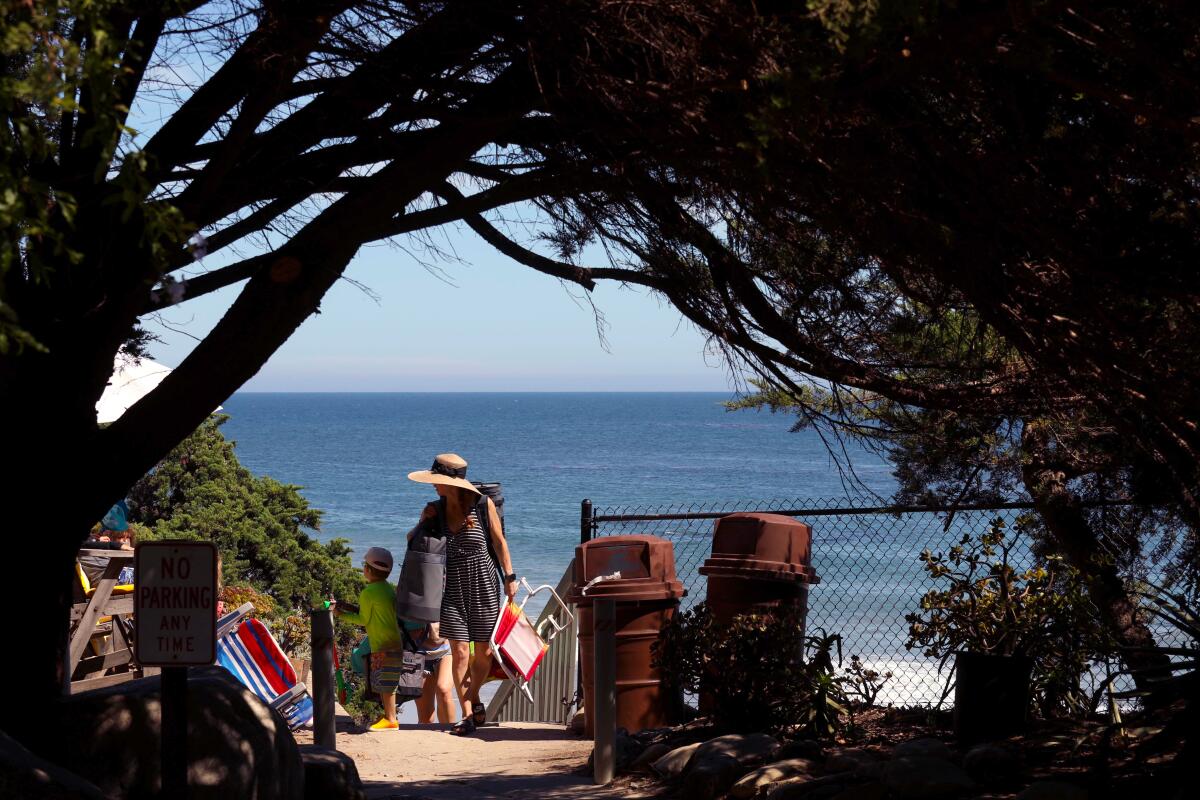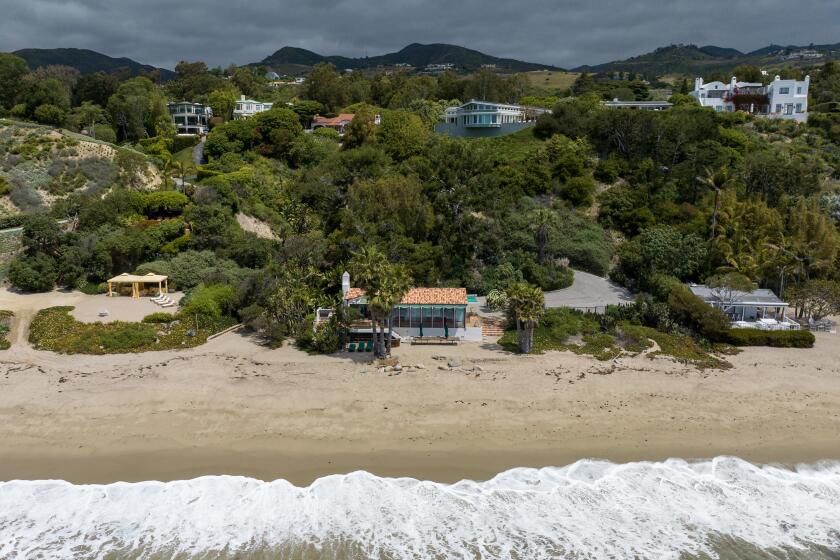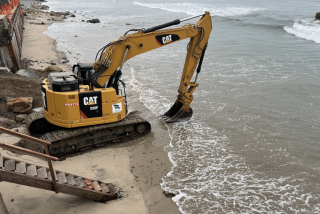Signs pointed the way to the beach. Malibu says, yes, the city took them down

- Share via
A Friday evening tweet sent by a preservation agency employee spotlighted a long-standing rift in the city of Malibu over beach access and nonmunicipal signs that point the way to the sand.
Edgar Del Campo, a Mountains Recreation and Conservation Authority employee, said in a one-minute message that Malibu officials had cut down and confiscated three signs directing visitors to Lechuza Beach, a pristine and difficult-to-reach jewel along the city’s 21-mile coastline.
The video showed Del Campo retrieving three 36-by-36-inch brown-and-white signs that say “coastal access” with an arrow, footprints and a wave, and three 8-by-36-inch blue “Lechuza” placards. Del Campo recovered the equipment at a city site Friday and placed the items in his white work truck while delivering a message to aspiring beachgoers.
“[We] wanted to let you and all Californians know that this beach is here and it is for your enjoyment,” he said.
For Elena Eger, MRCA coastal projects special counsel, Malibu’s actions were just another step by locals to limit outsider access that, in the past, included security guards.
“The coast is for everyone,” Eger said. “We encounter people who have been historically excluded from the beach, and it’s because they don’t have directions and they’re not in the know, and we’re here to give them directions and let them know about these great secret beaches.”
Malibu officials confirmed Monday that they had directed staff to remove three signs along Broad Beach Road, near Lechuza Beach, on June 26 in a story first reported by SFGate.com.
Malibu beaches lined with mansions may seem private, but they’re not. Here’s how to enjoy hidden spots with wonky access rules.
They shot back, however, at the notion they were trying to limit beach admittance.
“We have 15 million visitors a year to the city of Malibu, a tiny rural community,” Malibu Mayor Bruce Silverstein said of his seaside hamlet of around 10,000 people. “We welcome everyone and dissuade no one from coming here. To say anything else is disingenuous.”
Silverstein said that Lechuza was “hardly hidden”; he termed it “lesser known” than other beaches, such as Zuma. He noted that access to the beach follows a gated pathway through a residential neighborhood that has a sign at one entrance.
“This is 2023; everyone has a cellphone,” said Silverstein, 62. “You just plug in the directions and you’ll find the beach.”
City officials contended that the MRCA did not obtain permits to place those signs within city limits. The signs also did not follow city safety “break away” standards that make them collapse upon impact from a vehicle, a statement from city officials read.
The city statement maintained that staff “offered assistance to help MRCA apply for the permit, but MRCA did not request a permit.”
The city’s Public Works Department added in a note that “it would take two to three days for a public agency to get a city permit for a routine sign” like the ones taken down.
The move will restore a long-obscured access point to Escondido Beach from Pacific Coast Highway, the first new ‘vertical’ path to a beach in Malibu since 2015.
Eger said her agency did not need a permit. She added that the MRCA was following the city’s Local Coastal Program zoning and permit policy that allows exemptions for permits for “directional or safety signs required by law.”
“The reason why the [California] Coastal Commission and the local coastal plan require that there is no permit needed for directional signage is because people should be allowed to know where they’re going,” Eger said. “And it shouldn’t be a discretionary action on behalf of the city.”
Mario Sandoval, an MRCA coastal planner, said that his agency had been dealing with sign theft in Malibu for close to a year.
Originally, the three brown signs were placed along Broad Beach Road in August shortly after two other signs on Pacific Coast Highway were also erected, Sandoval said. All five were mysteriously taken down by October, with no one claiming responsibility.
These latest three signs were placed again on Broad Beach Road in June, Sandoval said, before the city confirmed it removed them June 26.
Eger called the act “very confrontational.”
Silverstein replied that the MRCA was “not a good neighbor” and was “constantly doing things they’re not supposed to be doing.”
The access wars that have flared anew this summer feel as old as the rocky point at one end of the Cove and as new as the next tide.
“Those signs were not lawfully put in the first place,” Silverstein said. “They just took the law into their own hands.”
Eger called Silverstein “uncooperative,” and Sandoval pointed to the mayor’s state of the city address in May as evidence of his desire not to work with the MRCA.
In the speech, Silverstein warned against “the invasion of millions of strangers who visit Malibu.”
“Malibu also has to contend with outside agencies whose mission is supposed to be to enhance our efforts to protect Malibu’s fragile environment and ecosystem, but which seem more interested in turning Malibu into a destination for visitors who litter our beaches,” he said.
Eger acknowledged, though, that the video tweet’s release on Friday was meant to provoke and, with hope, spur face-to-face negotiations.
“We wanted to sit down at the table and talk about this,” she said, “as opposed to just having a controversy.”
More to Read
Sign up for Essential California
The most important California stories and recommendations in your inbox every morning.
You may occasionally receive promotional content from the Los Angeles Times.














